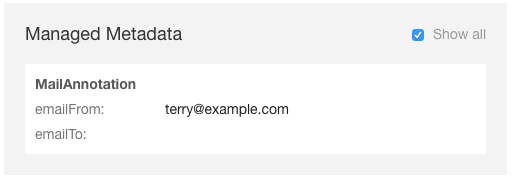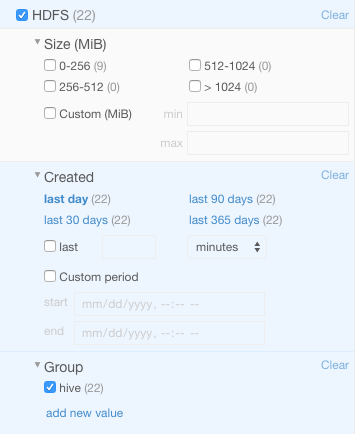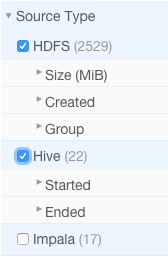Accessing Metadata
Minimum Required Role:: Metadata Viewer (also provided by Metadata Administrator, Full Administrator)
You can access metadata through the Navigator UI or through the Navigator API.
Navigator Metadata UI
Searching Metadata
- Start and log into the Cloudera Navigator data management component UI.
- Do one of the following:
- Type a search string into the Search box that conforms to the search syntax and press Return or Enter.
- Click the Click here link.
To display all entities, click Clear all filters and press Return or Enter. You filter the search results by specifying filters or typing search strings in the Search box.
Filter Example
The following filter example demonstrates how to narrow search results by selecting a built-in Source Type filter set to HDFS and the managed property emailFrom with the value terry@example.com.
Search Results
The Search Results pane displays the number of matching entries  in pages listing 25
entities per page. You can view the pages using the page control
in pages listing 25
entities per page. You can view the pages using the page control  at the bottom of each page.
at the bottom of each page.
- Source type
- Name - A link to a page that displays the entity details and lineage diagram
- Properties
- If Hue is running, a link at the far right labeled View in Hue that opens the Hue browser for the entity:
- HDFS directories and files - File Browser
- Hive database and tables - Metastore Manager
- MapReduce, YARN, Pig - Job Browser

Displaying Entity Details
- HDFS directories - Directory contents
- HDFS datasets and fields - Schema
- Hive and Impala databases - Tables and views
- Hive tables - Extended attributes, table schema, partitions
- Impala tables - Table schema
- MapReduce, YARN, and Spark operations - Instances
- Pig operation executions - Tables
If managed properties have been defined for a particular entity type, the Show All checkbox in the Managed Metadata pane displays all properties that can be assigned values for the selected entity. To display only those properties that have values, deselect the checkbox. If all properties have values, the checkbox has no effect.
To display entity details:
- Perform a search.
- In the search results, click an entity name link. The Details tab displays.
Hive Table Custom Metadata Example
For example, if you click the Hive table sample_07 link in the search result displayed in the preceding section, you could see the following
details:

In addition to the technical metadata, this Hive table has custom metadata consisting of tags tag1 and tag2, a custom key-value pair customkey-value, and an extended Hive attribute key-value pair key1-value1. The Details page also displays the table schema.
File-Managed Metadata Example
The following years directory entity has two managed properties in the MailAnnotation namespace: emailFrom and emailTo. The former is single-valued and the latter is multivalued.
In the following example, the Show All checkbox is selected. The emailFrom property is configured, but the emailTo property is not configured:

When the Show All checkbox is deselected, only the configured emailFrom property displays:

Filtering Search Results
To filter search results, specify filters in the Filters pane or type search strings in the Search box.
The Filters pane contains a set of default properties (source type, type, owner, cluster, and tags) and property values (also referred to as facets). You can add a filter by clicking
 in Add Another Filter... or by typing in the filter combo box to search for
it (additionally use the up and down keys) and pressing Return or Enter on the selected filter.
in Add Another Filter... or by typing in the filter combo box to search for
it (additionally use the up and down keys) and pressing Return or Enter on the selected filter.
As you add filters, filter breadcrumbs are added between Search box and search results, and search results are refreshed immediately. Multiple filters composed with the + operator are separated with the | character.

To remove non-default filter properties, click the  in the filter.
in the filter.
Specify a property value as follows:
- Boolean - Select the option to respectively not display, or display only those entries, with the value set to true: Do not show XXX (the default) or Show XXX only, where XXX is the Boolean property.
- Enumerated or freeform string
- Select the checkbox next to a value or click a value link.
- If a property has no values, click add a new value, click the text box, and select from the populated values in the drop-down list or type a value.
- Timestamp - Timestamps are used for started, ended, created, last accessed, and last modified properties. The server stores the timestamp in UTC, and the
UI displays the timestamp converted to the local timezone. Select one of the timestamp options:
- A Last XXX day(s) link.
- The Last checkbox, type or specify the value using the spinner control
 and select the unit minutes, hours, or days.
and select the unit minutes, hours, or days. - The Custom period checkbox and specify the start and end date.
- Date - Click the down arrow
 to display a calendar and select a date, or click a
field and click the spinner arrows
to display a calendar and select a date, or click a
field and click the spinner arrows  or up and down arrow keys.
or up and down arrow keys. - Time - Click the hour, minute, and AM/PM fields and click the spinner arrows
 or up and down
arrow keys to specify the value.
or up and down
arrow keys to specify the value. - Move between fields by clicking fields or by using the right and left arrow keys.
- Date - Click the down arrow
To remove filter values, click the  in the breadcrumb or deselect the checkbox.
in the breadcrumb or deselect the checkbox.
When you select a specific source type value, additional properties that apply to that source type display. For example, HDFS has size, created, and group properties:

The number in parentheses (facet count) after a property value is the number of extracted entities that have that property value:

Facet values with the count of 0 are not displayed.
When you type values, the value is enclosed in quotes; the value inside the quotes must exactly match the metadata. For example, typing "sample_*" in the originalName property returns only entities whose names match that exact string. To perform a wildcard search, type the wildcard string in the Search box. For example, typing the string "sample_*" in the Search box returns all entities with "sample_" at the beginning of their original name.
+(sourceType:hdfs sourceType:hive) +(type:file type:directory)and:
((+sourceType:hdfs +created:[NOW/DAY-30DAYS TO NOW/DAY+1DAY]) sourceType:hive)
Navigator Metadata API
The Navigator API allows you to search entity metadata using a REST API. For information about the API, see Cloudera Navigator Data Management API.